Zoom
Trash

A Peek at a ‘Smart’ Classroom Powered by the Internet of Things. It’s getting harder to go more than a week perusing technology websites without coming across a reference to the “Internet of Things”—a term broadly referring to the idea that objects like household appliances will be embedded with sensors that collect and transfer data and alter their activities without direct human input.
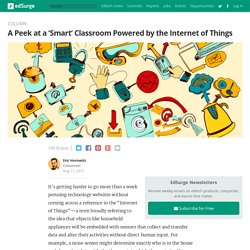
For example, a noise sensor might determine exactly who is in the house and share that data with the thermostat, which then sets itself to the preferred temperature of those who are present. Resources Toolkit for New Teachers. Before you dig in to the resources, consider advice from veteran educator Elena Aguilar in her post, "What I Wish I'd Known as a New Teacher.
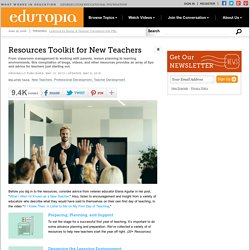
" Also, listen to encouragement and insight from a variety of educators who describe what they would have said to themselves on their own first day of teaching, in the video "If I Knew Then: A Letter to Me on My First Day of Teaching. " Preparing, Planning, and Support. Amany Atef sur Twitter : "Let's tweet things that can change the education! Use #WhatIf hashtag. #edtech #eLearning #education #mLearning. Antonella Poce sur Twitter : "#eden15 Antonio Texeira president introducing eden! Expanding Learning Scenarios - #EDEN15 Annual Conference Wednesday Live Channel. Amany Atef sur Twitter : "A Great New Technology Integration Matrix for Teachers - #edtech... Educational Technology and Mobile Learning: A Great New Technology Integration Matrix for Teachers.
Amany Atef sur Twitter : "#WearableTechnology #Future #edtech... Social Media in Education: Resource Toolkit. Creating Social Media Guidelines A Guidebook for Social Media in the Classroom, by Vicki Davis (2014) Davis, in the first half of a pro-and-con discussion about social media in the classroom, positions it as a vital life skill and provides 12 positive examples of classroom use.
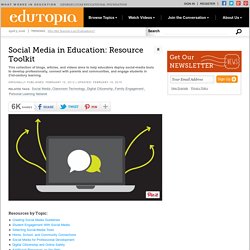
For the second half of the discussion, read this post by Ben Johnson: "Too Much Technology and Not Enough Learning? " The Digital Lives of Teens: What Time Is It? Now! By Matt Levinson (2013) In this first installment of his Digital Lives of Teens series, Levinson considers the problem of translating the teenage urgency of 'always on' into the mindfulness of 'being present.' 2015-nmc-horizon-report-HE-EN.pdf. The Implications of Wearable Technology in the Classroom - Nibletz. In a session entitled, “Wear to Learn: The Body As an Interface,” Emory Craig – the director of eLearning at the College of New Rochelle – and Maya Georgieva – Associate Director of the Center for Innovation in Teaching and Learning at New York University – addressed some of the implications of wearable technology in the classroom.1 Craig and Georgieva began with a broad overview of the topic, but then posed several questions to the audience, prompting a lively discussion.
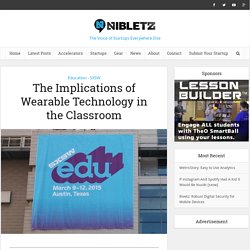
Craig and Georgieva both did an excellent job presenting the topic, as well as guiding the group discussion. Much more than a talk about wearable devices, however, the discussion provided a glimpse into how educators – the audience by and large – view and think about the potential benefits and consequences of such products in the classroom.
Maya Georgieva and Emory Craig The prompt questions covered four complex issues surrounding the use of wearables in an educational setting. 5 Ways to Create Motivation Using eLearning Scenarios. Scenarios are the proving ground of eLearning.
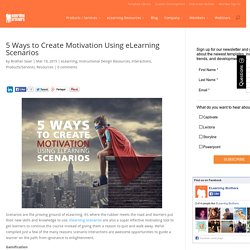
It’s where the rubber meets the road and learners put their new skills and knowledge to use. 5 Elements To Better Connection And Communication With Online Students. My philosophy on teaching online adult learners is centered on building a solid relationship that establishes the instructor first and foremost as the real person committed to the process of learning.

This article is about the 5 elements you can use to achieve better connection and communication with online students. To make herself truly tangible and three dimensional for her students, the instructor must make every effort to communicate across multiple modes of media as well as be responsive and available in the ways that best suit her student population. To achieve better connection and communication with online students: Use visual elements. This could mean something as simple as uploading a picture to accompany a discussion board post, or using an avatar or a favorite photo if privacy is a concern. The Teacher's Guide To Twitter. Twitter has proven itself to be an indispensable tool for educators around the globe.

Whatever skill level you may be, Twitter is downright fun and worth your time. So here’s a useful guide that we curated from Edudemic’s archives in an effort to put something together that was a bit easier to read than random blog posts. We hope you enjoy and will be regularly adding to this guide so feel free to leave your ideas down in the comments or by, what else, tweeting us @edudemic anytime! Our Biggest Twitter Tips For Teachers For many teachers making a foray into the edtech world, Twitter is an excellent tool for consuming and learning.
Many are also harnessing Twitter as a part of their PLN (personal learning network) to connect, share, and network. Check out our biggest Twitter tips for teachers below! Create, Don’t Just Consume The best way to get the most out of Twitter is to use it. Pedagogy-and-technology-integrating-the-5-cs-of?utm_content=buffer45212&utm_medium=social&utm_source=twitter. Social Media for Teachers: Guides, Resources, and Ideas. Although students are evermore connected to the social web, many of these networks remain out-of-class digital playgrounds where students congregate.
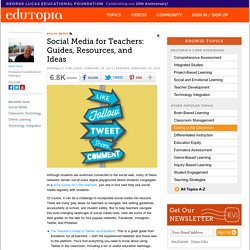
In a 2014 survey of 1,000 teachers, just one in five said they use social media regularly with students. Of course, it can be a challenge to incorporate social media into lessons. There are many gray areas for teachers to navigate, like setting guidelines, accessibility at school, and student safety. But to help teachers navigate this ever-changing landscape of social media tools, here are some of the best guides on the web for four popular networks, Facebook, Instagram, Twitter, and Pinterest. More Great Reads From Edutopia. Pedagogy-and-technology-how-to-build-a?utm_content=buffera2450&utm_medium=social&utm_source=twitter. Fishtree Education sur Twitter : "The 3 Circles of 21st century Learning Platforms #21stEdChat #1to1techat #edtech.
Common Core Alignment. Making-mobile-technology-personalized-not-just?utm_content=buffer646d2&utm_medium=social&utm_source=twitter. Edtech.